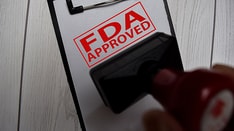Approach Considerations
Neutropenia is usually discovered during the workup of a febrile illness. Leukopenia and neutropenia are also often discovered incidentally, as a result of a routine CBC or a CBC performed for an unrelated reason.
The clinical severity and frequency of infections, rather than the severity of neutropenia, should dictate the extent of laboratory workup, since finding a periodic drop in the neutrophil count to zero is not uncommon in AIN. [38] Lindqvist et al published an algorithm for the workup of children with neutropenia that may be practical and helpful. [14]
Go to Neutropenia for complete information on this topic.
CBC
A CBC demonstrates a white blood cell (WBC) count that is either decreased or within the reference range and a neutrophil count of less than 1000/µL in infants and < 1500/μL in older children.
Performing sequential CBCs with differential to document chronicity is important, because most neutropenia in infants resolves with recovery from an acute infection. In individuals with autoimmune neutropenia, the absolute neutrophil count often remains less than 500 (see the Absolute Neutrophil Count calculator).
Monocytosis and eosinophilia may occur, although significant eosinophilia or monocytosis is rare, unlike in severe congenital neutropenia. In individuals with primary autoimmune neutropenia, hemoglobin and platelet counts are normal. In patients with secondary autoimmune neutropenia, associated anemia, an increased reticulocyte count due to hemolysis, and thrombocytopenia may be present. Presence of immature white blood cells, including blasts, suggests leukemia.
Antinuclear antibodies may be positive in patients with secondary autoimmune neutropenia, although only rarely in infants. Direct antiglobulin test (DAT) or direct Coombs test results may be positive in individuals with secondary autoimmune neutropenia; perform this study when evidence of hemolysis or thrombocytopenia (Evan syndrome) is present.
Multi-lineage cytopenias virtually exclude AIN, and other etiologies should be promptly considered.
Tests for Neutrophil Antibodies
Documentation of neutrophil antibodies is not always necessary for patients with a benign course of AIN. In addition, an absence of demonstrable antineutrophil antibodies does not exclude the diagnosis. The age of onset, a benign clinical course, and normal bone marrow findings are sufficient to make a diagnosis of PAIN. In addition, research has indicated that, in some patients, antibodies detected at the onset are not detectable on retesting before the patient has recovered. [37] Thus, antibody test findings may not always be positive, depending on the timing. Also, sensitivity for antibody detection varies depending on the test. The indirect granulocyte immunofluorescence test (GIFT) is more sensitive than monoclonal antibody-specific immobilization of granulocyte antigens (MAIGA). It appears that panantibodies to Fc gamma RIIIb are positive during the early period of neutropenia, but they disappear earlier than HNA-1 antibodies. [9] (Patients with detectable antineutrophil antibodies may have congenital neutropenia due to ELANE mutation. In these instances, early initiation of G-CSF may be lifesaving. [7] ) Boxer et al found no difference in the rate of spontaneous recovery between antibody-positive and antibody-negative patients with chronic autoimmune (or idiopathic) neutropenia, casting significant doubt on the usefulness of antibody testing. [7]
Bone Marrow Examination
Bone marrow examination is often necessary to exclude other diagnoses, in particular leukemia, although bone marrow findings are not diagnostic of this disorder.
The bone marrow may be hypercellular or normocellular with myeloid hyperplasia. However, it can be completely normal, including physiologic lymphoid hyperplasia.
In clinically severe instances of AIN, "maturation arrest" may be observed, in that there is a paucity or absence of mature neutrophils. However, a preponderance of myelocytes, metamyelocytes, and bands may be present. In rare instances, intramedullary phagocytosis of granulocytes may be observed. [19]
Serum Immunoglobulin Quantitation
Serum immunoglobulin quantitation helps to exclude neutropenia associated with hypogammaglobulinemia or hyper-IgM syndrome.
Histologic Findings
In most instances, bone marrow findings are normal. Maturation arrest at promyelocyte or myelocyte stage typically seen in severe congenital neutropenia is absent. Absence of leukemic blasts excludes a diagnosis of leukemia.
Often, an increased number of mature lymphocytes consistent with the patient's age are present.
Laboratory Studies
Although, as previously indicated, demonstration of anti-neutrophil antibodies is not necessary to establish the diagnosis of PAIN, there are several tests available to reveal such antibodies. The most commonly used one is the indirect granulocyte immunofluorescence test (I-GIFT), which detects circulating antibodies in the patient's serum. The direct GIFT (D-GIFT) detects neutrophil-bound antibodies on the patient's cells. D-GIFT currently is available only in research laboratories; it is difficult to perform due to the reduced number of neutrophils in patient samples. Porretti et al reported higher sensitivity for D-GIFT compared with I-GIFT, but there were many false-positive results with this test, showing lower specificity. [4]
In addition to the GIFTS, other tests used to detect anti‐HNA antibodies are the granulocyte agglutination test (GAT) and monoclonal antibody–specific immobilization of granulocyte antigens (MAIGA). [6] These tests require fresh control granulocytes from volunteers, and thus are difficult to perform in routine clinical laboratories. Because of this limitation, Onodera et al developed the extracted granulocyte antigen immunofluorescence assay (EGIFA). [6] By using prepared extracted human HNAs (HNA-1a, -1b , and -2) bound to microspheres, the investigators were able to determine the intensity of immunofluorescence associated with the patient's serum through antibodies reacting with respective antigens. The procedure, however, is extremely cumbersome and not reproduced by other laboratories. Some investigators have used fresh-frozen bone marrow slides to detect anti-HNA instead of blood slides; a 53% sensitivity and 100% specificity were reported using the bone marrow slides. [39]
-
A case of secondary autoimmune neutropenia. This patient presented with recurrent otitis and areas of cellulitis in the diaper area. Pseudomonas aeruginosa and Staphylococcus aureus were isolated from the skin lesions. Autoimmune hemolytic anemia and autoimmune neutropenia were confirmed based on the presence of autoantibodies. The patient has a mutation on exon 15, A504T, which changed an asparagine residue to a valine residue.








